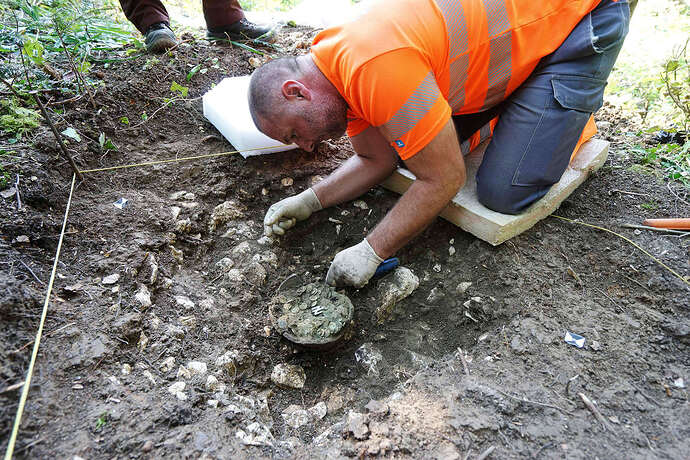For once being an archaeologist (working in Norway, no less) is a useful trait to have!
The proper protocol is to leave it the hell alone as soon as you know it is of archaeological significance. Take a GPS reading, mark it in an unobtrusive way if you think you won’t be able to find it again (and you probably won’t, if you don’t!), and call your local archaeologist. In the case of Norway, this is your local university museum, although you can also try the local council (fylkeskommune) who have their own archaeologists that can survey the find and kick it up the chain. Absolutely do not dig it by yourself! It is extremely unlikely anyone will find it while you are away for a day or two. It has been lying there for thousands of years, as long as you disguise your digging, what are the odds someone stumbles upon it in the next days or weeks?
Your instinct is the right one, but I don’t understand why coins are the exception. Professionally excavating a coin hoard preserves information that even the most diligent of amateurs simply cannot provide. For example, it can give information about what container was used. Nobody just pours coins into a hole. If it looks like there was no obvious container, such as a ceramic pot, then an organic container (maybe a leather sack or a wooden box) was used which didn’t survive, but which can still be reconstructed by techniques such as the careful recording of coin positions or of any nails or applications. Soil samples and micromorphology profiles can also be taken to answer this question.
Recording each coin as a unique object allows the study of deposition (were they added year after year or is it just one big jumble?). A bigger excavation around the area can show whether this was an isolated incident or whether it was maybe deposited under the hearth of a building (a common spot for these hoards).
Finally, a proper excavation allows us to be sure that the artefacts actually belong together and this isn’t a scam where someone is trying to “whitewash” a collection they got elsewhere because it was acquired illegally. Look at the shadow that still hangs over the Nebra Sky Disk to see why this is important. Coins, especially, are easy to combine from different finds and pass off as a hoard. Often, it is relatively easy for numismatists to show that it is unlikely they belong together, but there will always be a shadow of doubt, and that is a lot of energy and money spent unnecessarily.
These are just some of the questions that come immediately to mind. There are many others that could be answered only if excavated professionally. Unlike an amateur, btw, archaeologists these days will most likely retrieve the hoard as a single block, encased in plaster of paris, so that it can be excavated and documented in the lab under controlled conditions and with conservation being available the second an object emerges from the soil.


